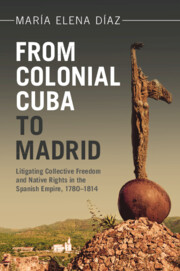 From Colonial Cuba to Madrid
From Colonial Cuba to Madrid Book contents
- From Colonial Cuba to Madrid
- Afro-Latin America
- From Colonial Cuba to Madrid
- Copyright page
- Contents
- Figures and Tables
- Acknowledgments
- Introduction
- 1 Imperial Reform, Privatization, and Enslavement
- 2 An Unorthodox Pueblo and Its Apoderados
- 3 Making the Case for Collective Freedom
- 4 Native Bonds, Native Rights
- 5 The Council’s Ruling and the Politics of Litigation
- 6 A “Pernicious” Communication
- 7 Violence, Marronage, and Litigation
- 8 The Final Outcome of the Case
- 9 The Nineteenth-Century Afterlife of the Freedom Edict of 1800
- Conclusion
- References
- Index
1 - Imperial Reform, Privatization, and Enslavement
Published online by Cambridge University Press: 14 November 2024
- From Colonial Cuba to Madrid
- Afro-Latin America
- From Colonial Cuba to Madrid
- Copyright page
- Contents
- Figures and Tables
- Acknowledgments
- Introduction
- 1 Imperial Reform, Privatization, and Enslavement
- 2 An Unorthodox Pueblo and Its Apoderados
- 3 Making the Case for Collective Freedom
- 4 Native Bonds, Native Rights
- 5 The Council’s Ruling and the Politics of Litigation
- 6 A “Pernicious” Communication
- 7 Violence, Marronage, and Litigation
- 8 The Final Outcome of the Case
- 9 The Nineteenth-Century Afterlife of the Freedom Edict of 1800
- Conclusion
- References
- Index
Summary
Focusing on the relation and conflict between imperial, colonial, and local levels, Chapter 1 lays out the historical context that gave rise to the collective freedom suit. It first traces the process of making law and policy according to the imperial state’s reform imperatives here directed at the privatization and revival of an extractive metal industry based on the once rich copper mines of El Cobre near Santiago de Cuba. Crucial to the production of artillery in the Crown’s arms industry, copper was at the time a strategic resource for the imperial state. But for the beneficiaries of the privatized mining estate, the most valuable resource were the former royal slaves who had long lived in quasi freedom as an unconventional pueblo in the mining jurisdiction. A growing demand for slaves in the colony led to the re-enslavement, removal, and sale of hundreds of cobreros, or natives of El Cobre, thereby upending former local customary practices. A denied offer for a collective self-purchase, or coartación, and land eventually led to a wrongful enslavement action in Madrid. The chapter shows the major impact of imperial Bourbon reforms and of global factors in this so-called hinterland region of empire.
Keywords
- Type
- Chapter
- Information
- From Colonial Cuba to MadridLitigating Collective Freedom and Native Rights in the Spanish Empire, 1780–1814, pp. 30 - 62Publisher: Cambridge University PressPrint publication year: 2024
